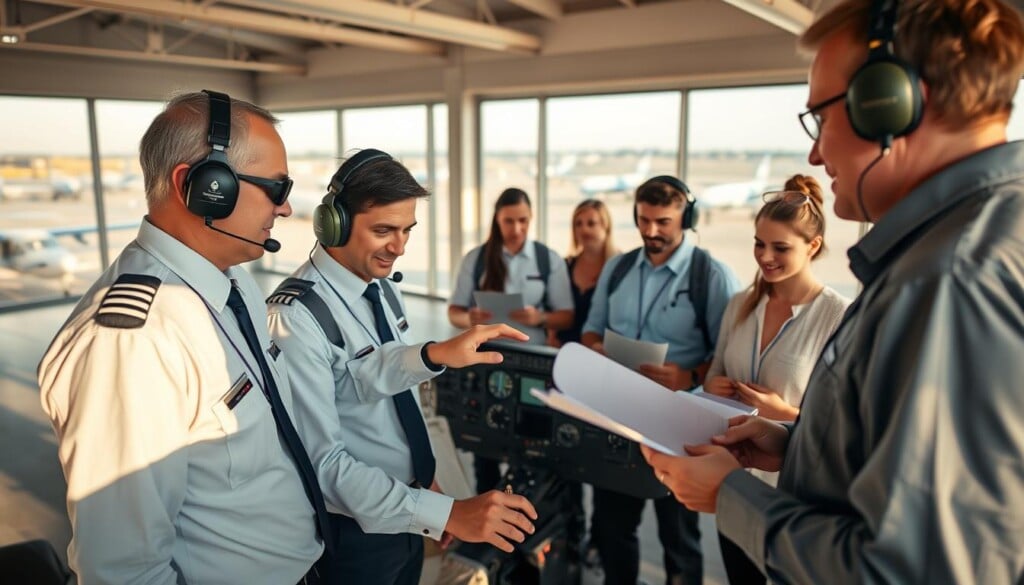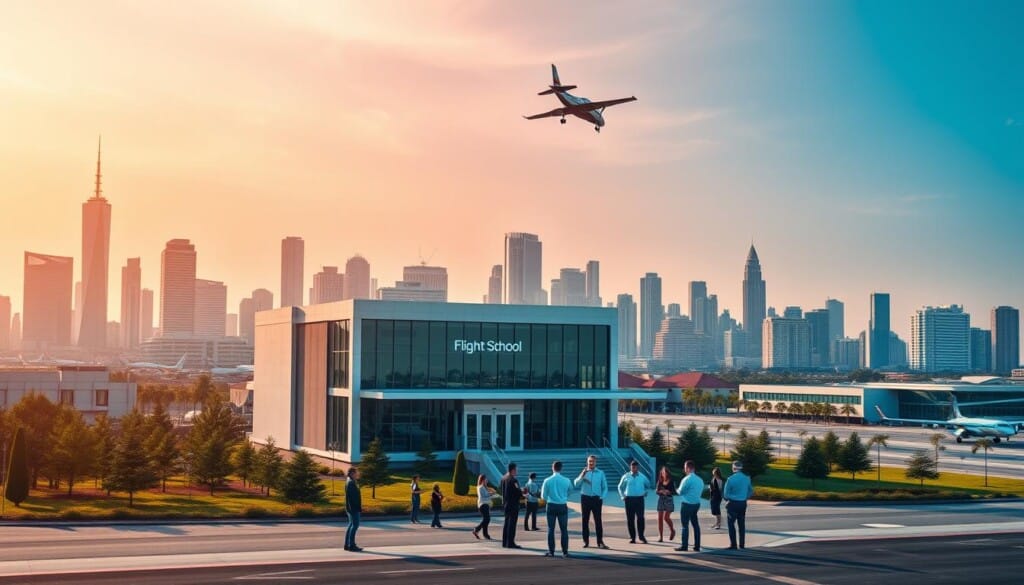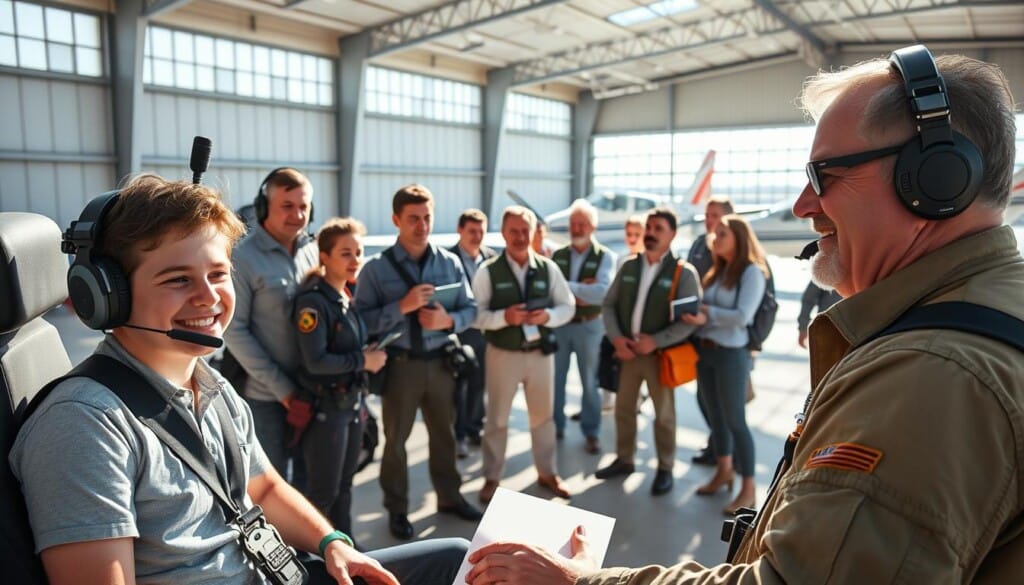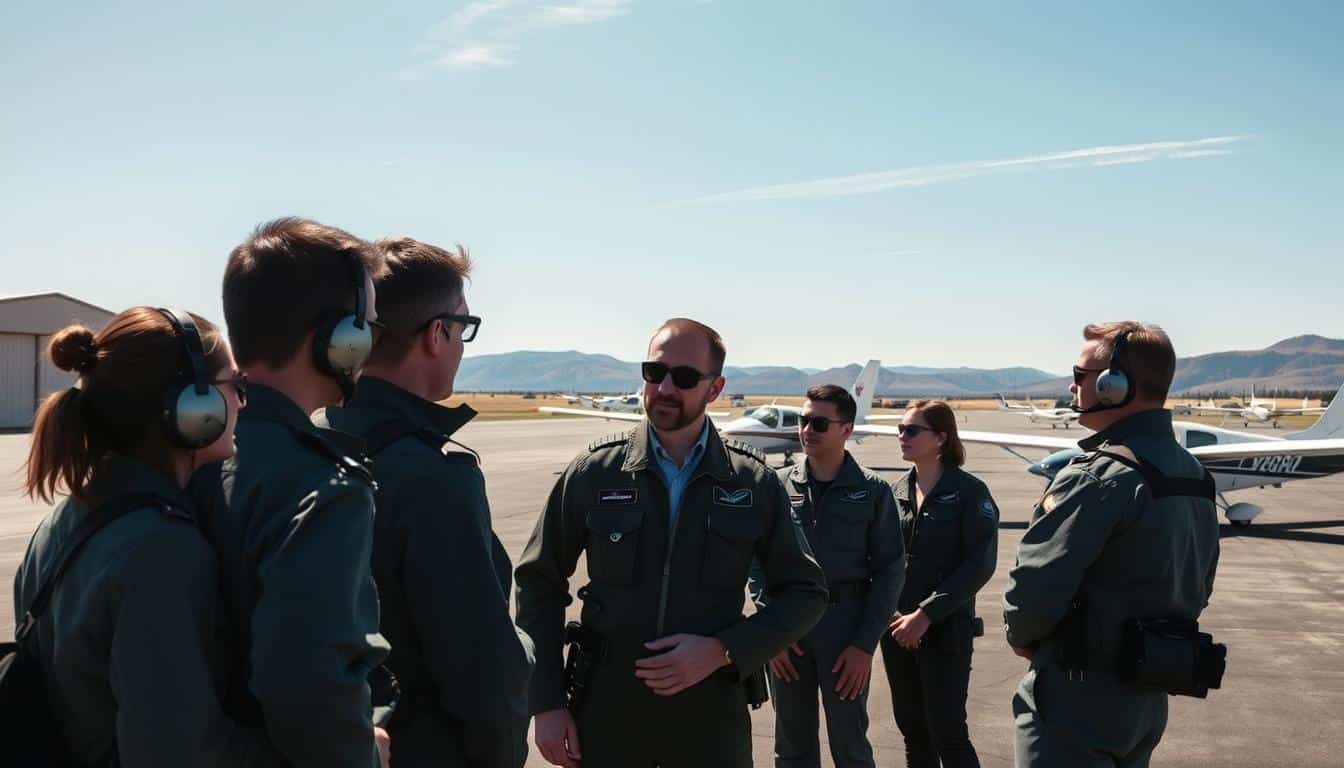Ever thought about what it takes to be a great pilot in today’s fast world? The need for skilled pilots is growing fast. This makes top-notch flight training a must for those who want to fly.
In the United States, there are many flight schools. They offer classes for all levels. This helps students go from beginners to licensed pilots easily. This guide shows why good flight training is key and what to look for in a flight school.
Key Takeaways
- Understanding the increased demand for trained pilots in the aviation sector.
- Importance of selecting a reputable flight school for effective pilot training.
- Overview of structured curricula offered by flight schools across the country.
- Transitioning from novice to skilled pilot: the role of professional guidance.
- Benefits of enrolling in aviation classes tailored to individual needs.
How Flight Instruction Works
Flight training is key for those wanting to become pilots. It mixes theory with practical skills needed for safe flying. Students learn about aviation basics, rules, and weather in ground school. They also get hands-on experience in real or simulated flights.
Understanding the Flight Training Process
Students learn about flying mechanics and operations in structured lessons. Ground school gives the theory, while flying sessions help them practice. They get feedback from experienced instructors.
Types of Flight Instruction Available
There are many types of flight training, like private, commercial, and instrument. Each focuses on specific skills needed for different levels of flying. This way, students get the right training for their goals.
Benefits of Professional Flight Training
Professional flight training improves flying skills and safety awareness. It follows rules and helps get pilot certification. It also opens up more career chances in aviation, preparing pilots for various aircraft.
Types of Pilot Licenses Available
People wanting to become pilots can choose from different licenses. Each license has its own goals and skill levels. Knowing the difference between a Private Pilot License, Commercial Pilot License, and Airline Transport Pilot License helps pilots pick the right training path.
Private Pilot License (PPL)
The Private Pilot License (PPL) is for those who want to fly for fun. It lets you fly without a teacher nearby. But, you can’t fly for money or in a job.
This license teaches you the basics of flying. You learn about flight rules and how to safely operate an aircraft.
Commercial Pilot License (CPL)
Getting a Commercial Pilot License (CPL) opens up more career options. With it, you can fly for money. This is great for jobs like charter flights, teaching flying, and air tours.
This license requires more skills and knowledge than the PPL. You need to understand aviation rules better.
Airline Transport Pilot License (ATPL)
The Airline Transport Pilot License (ATPL) is the highest pilot certification. It’s needed to fly big commercial airplanes. To get it, you need lots of training, flight hours, and tough exams.
This license means you have top skills and knowledge. You can handle complex aircraft and keep passengers safe.
Choosing the Right Flight School
Choosing a flight school is a big decision for aspiring pilots. Many factors are important, like accreditation, instructor skills, and the types of planes available. Also, the number of students per instructor and safety rules matter a lot. These things affect how well you’ll learn to fly.
Factors to Consider When Selecting a Flight School
First, check if the school is accredited. This means it meets industry standards. Then, look at the instructors’ qualifications. They should be good teachers.
Also, see what kinds of planes the school has. Having many types is better for learning. And, a small student-to-instructor ratio means you get more attention. This can help you learn faster and do better.
Top Flight Schools in the USA
In the USA, some schools are known for their great pilot training. Places like Embry-Riddle Aeronautical University and the University of North Dakota are top choices. They have experienced teachers and modern facilities to prepare you for flying.
Evaluating Flight School Reputation
To judge a flight school’s reputation, look at what students say. Read about their experiences and how they did after graduating. Also, check what aviation authorities say about the school’s safety and operations. Knowing this helps you make a smart choice for your flying career.
The Importance of Experienced Instructors
Experienced instructors are key to success in flight training. They have the skills and knowledge to help students learn. Knowing what makes a good instructor helps aspiring pilots find the right mentor.
Qualities of an Effective Flight Instructor
Good instructors have strong communication skills and deep industry knowledge. They need patience to help students understand complex ideas. They also give feedback that helps students grow and learn.
What to Expect from Your Instructor
Students get training that fits their learning style. Instructors check their skills often and help improve weak areas. This builds confidence and prepares students to be pilots.
The Role of Mentorship in Flight Training
Mentorship is a big plus in flight training. It helps students face challenges and make smart flight decisions. A good mentor helps develop skills and teaches professionalism.

Flight Instruction Costs and Financing Options
Understanding the financial side of flight instruction is key for those who want to fly. The cost of flight training varies a lot. It depends on the license you want and the school you choose. On average, getting a private pilot license in the USA costs between $13,000 and $15,000.
This price includes renting an aircraft, paying for instructors, and buying study materials.
Average Cost of Flight Training in the USA
The cost of flight training changes based on where you are, the type of plane, and the school’s facilities. Even though it’s a big upfront cost, knowing you’ll earn back your investment as a pilot can motivate you. It’s a chance to follow your dreams in aviation.
Financing Options for Aspiring Pilots
There are many ways to finance your flight training. You can get loans from banks, aviation lenders, or payment plans from schools. These options help spread out the cost, making it easier to manage.
They also help you invest in your future career without too much financial stress.
Scholarships and Grants for Flight Training
Scholarships for flight training can really help lower costs for students. Many groups and schools offer financial help for aspiring pilots. These resources make it possible to start your aviation career without too much financial worry.
LocalZ: Connecting Aspirants with Flight Schools
LocalZ is a key resource for those looking for flight instruction near them. It makes finding flight schools easy, helping aspiring pilots find the right school for their goals. This directory offers a wide range of educational options in aviation.
How to Find Flight Instruction in Your Area
On LocalZ, you can find flight instruction by your location. Just enter your city, state, or zip code to find nearby schools. This helps future pilots connect with local schools that meet their training needs.
The Search Process on LocalZ
The search on LocalZ is easy to use. You can filter results by distance, training programs, and student reviews. This makes it simple for aspiring pilots to find the perfect school for their education.
Sample Listings of Flight Schools Near You
LocalZ lists many flight schools, giving you important details about each. You can learn about their specialties, instructor qualifications, and the aircraft used for training. This helps students make the best choice for their flight training.

Community Engagement in Flight Training
Community engagement is key for aspiring pilots and aviation education growth. Local flight schools offer training and act as community centers. They build relationships and encourage teamwork among aviation fans.
Supporting Local Flight Schools
Backing local flight schools is vital for a strong aviation system. They provide education and networking chances. By supporting them, we help the industry grow and ensure training for future pilots.
Networking Opportunities in Aviation Communities
A lively aviation community offers many networking chances. Events like airshows and seminars connect new pilots with experts. Joining local groups helps share knowledge, get advice, and make friends, boosting growth in aviation.
LocalZ’s Commitment to Community Organizations
LocalZ is dedicated to community support, giving 50% of its fees to local groups. This helps connect flight schools with their communities. It shows the value of these schools and helps them grow.
Flight Instruction Success Stories
Looking into the lives of successful pilots, we find many stories of triumph. Their paths show how hard work and good training can change lives. These tales inspire those who dream of flying to reach for the sky.

Inspiring Journeys of Successful Pilots
Many pilots began with a love for flying. They turned this passion into a fulfilling career. They followed a structured training plan and got help from seasoned instructors.
This approach laid a strong base for their success. It’s a key part of many pilots’ stories.
Testimonials from Local Flight Schools
Flight schools share stories of how great teachers make a difference. Students say that engaging teachers sparked their interest. They helped grow their skills.
These stories show how good teaching leads to success. It turns dreams into reality.
Case Studies of Flight School Graduates
Case studies look at how graduates did after school. They show how good training leads to better jobs. Alumni say their school gave them the skills and confidence to succeed.
To find quality programs, check out LocalZ. It connects you with top educational resources.
Staying Safe in the Sky
Keeping safe in flight training is key for future pilots. It’s about more than just flying skills. It’s about following strict rules and understanding their importance. This knowledge helps pilots succeed and feel responsible.
Importance of Safety in Flight Training
Safety in flight training is very important. Trainees learn that safety is a way of thinking. It guides their choices in training and real flights. This way, they get used to thinking about safety all the time.
Regulations and Standards Governing Flight Instruction
Flight rules are vital for safety in training. They make sure schools teach all safety steps. These rules help create a solid training base, showing how important following them is.
Emergency Procedures and Training
Learning emergency steps is a big part of training. Trainees learn how to handle unexpected situations. Knowing these steps makes pilots safer and more confident in tough situations.
The Future of Flight Instruction
Flight instruction is changing fast, shaping the future of flight training. New technology is making learning better and safer. This helps future pilots to do well and succeed.
Trends in Aviation Education
More people want to be pilots, so education is changing. Now, students use advanced simulators and virtual reality. This lets them practice flying in a safe way.
It also helps them understand aircraft systems better. This is key for flying safely.
Technology’s Role in Flight Training
Technology is changing how pilots are trained. It makes learning more efficient and effective. Tools like online courses and real-time tracking are now common.
These tools help instructors teach both theory and practical skills. This prepares pilots for today’s aviation world.
The Next Generation of Pilots: A Look Ahead
As we look to the future, pilots-to-be need to know about new education trends. Technology makes learning easier and prepares students for the changing aviation world. Knowing this helps new pilots handle the challenges of flying today.

